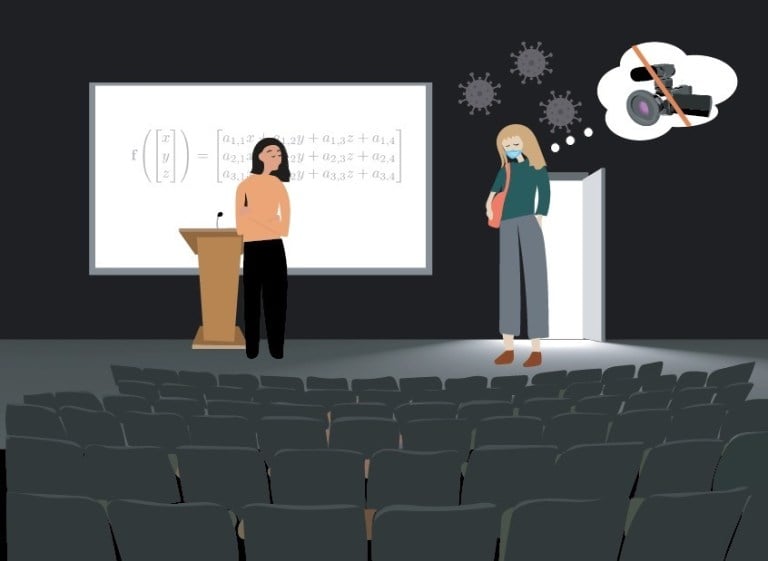By Jacob Budnitz
This past quarter, students and faculty alike noticed that lectures were constantly interrupted by a cacophony of coughing from students.
In previous years, such coughing could be written off as the flu or common cold making its seasonal rounds. In the middle of a pandemic, however, Stanford can no longer afford to treat students coughing en masse so casually. Instead, Stanford must actively encourage students feeling sick or exhibiting COVID-19 symptoms to recuse themselves from attending class to prevent them from potentially infecting others.
Currently, many courses incentivize sick students to attend class by not providing complete lecture recordings. While lecture notes, PowerPoint slides or audio recordings do mitigate the effects of missing class for an illness, they don’t provide the full benefit that a complete lecture recording (a recording that includes both video and audio of the lecture) provides. Lecture notes rarely capture the nuanced components of a lecture, PowerPoints often omit the connections between the material on individual slides for the sake of brevity and audio recordings are difficult to follow because of ambiguous references to “this” and “that” which only make sense with a visual aid.
Thus, if a course does not provide a complete lecture recording, sick students are forced to choose between the health of their classmates and doing well in their courses.
However, this choice is one that students should not have to make. And it’s also one that the University could easily eliminate by requiring that complete recordings be provided for all lectures, at least for the duration of the COVID-19 pandemic. Hopefully, such a requirement would remove any incentives that potentially sick students might have to come to class and consequently reduce the spread of COVID-19 and other illnesses.
While this solution may sound easy to achieve, there are significant yet definitely surmountable obstacles to its implementation.
The most challenging obstacle to providing students with full video and audio recordings is likely the issue of consent. For lecture recordings to be made available, all participants must consent to be recorded. During the 2020-2021 academic year, consent was easily obtained as Zoom prompted everyone participating in the live lecture to acknowledge that the recording was “in progress” before participating. Now, with in-person instruction tentatively set to resume week three of the winter term, obtaining consent may be less convenient, but it’s not impossible. For example, the University could require all lecture participants to consent to be recorded for the winter quarter prior to the start of in-person instruction.
In addition to obtaining participants’ consent, the University would have to provide the equipment and labor needed to record lectures and make them available to students. To overcome this obstacle, Stanford only needs to purchase video and audio recording equipment and train TAs how to use it — a feat that MIT has demonstrated to be achievable through MIT OpenCourseWare (even with an endowment around $10 billion less than Stanford’s).
Some professors have also expressed concerns that if lecture recordings are made available on demand, in-person lecture attendance could decrease and students may not retain material as well by watching online recordings (compared to attending lectures in person). Even if lecture recordings decrease in-person lecture attendance, the claim that student learning would automatically suffer as a result is not necessarily true. Educational research focusing on students at Harvard Medical School has found that students find “video-recorded lectures equally or more valuable” than attending lectures in-person. This student preference for recorded lectures instead of live ones can likely be attributed to the fact that a majority of students report that watching recorded lectures makes them more likely to “increase their speed of knowledge acquisition” (>79% of students), “look up additional information” (>67%) and “stay focused” (>64%). To many Stanford students, these findings are not surprising as most have experienced lectures that go too slow to keep our attention, too fast to allow us to look up references necessary for understanding material or are just simply difficult to focus on for long periods of time.
However, even if providing complete lecture recordings does negatively impact student learning, Stanford must allow its students to make the decision to incur that negative outcome — the University can’t hold its students’ hands forever.
From limiting student gatherings to indoor mask mandates, Stanford has already implemented restrictions aimed at curtailing a person’s potential to spread COVID-19, regardless of whether the person is actually at risk of doing so. If Stanford is truly committed to stopping COVID-19, then it must encourage students with signs or symptoms of infectious illness to stay away from large indoor gatherings like classroom lectures, as this is a fundamental, universally recommended measure to protect our community. Providing full video and audio recordings for all lectures, at least for the duration of the COVID-19 pandemic, should be immediately implemented as it is a reasonable, rational requirement to help protect our fellow students, faculty and staff.
